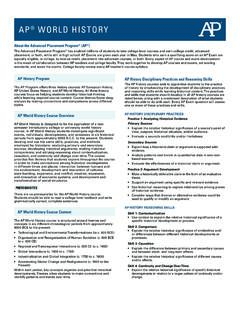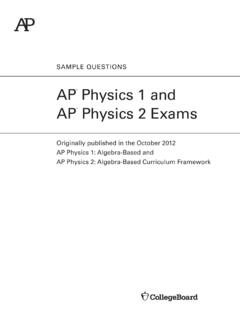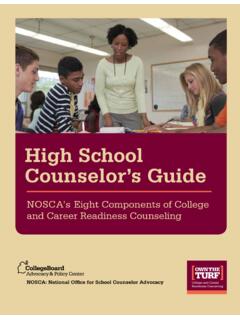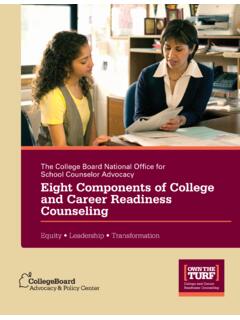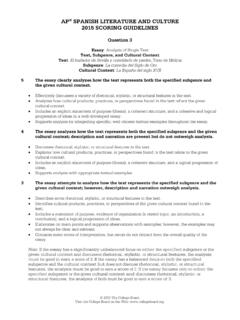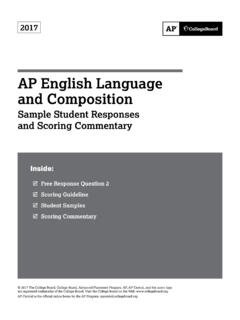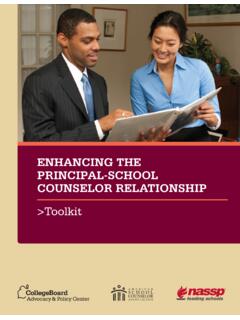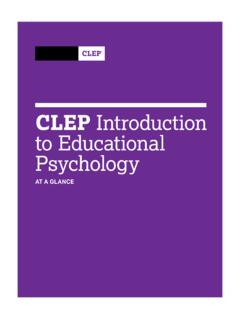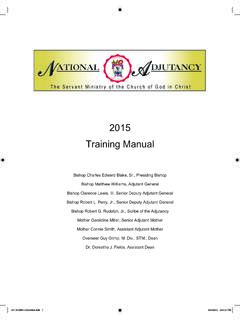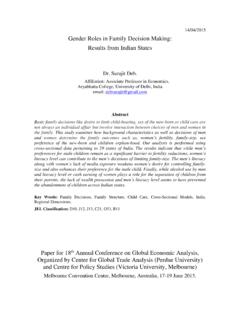Transcription of ap09 us history q5 - College Board
1 AP UNITED STATES history 2009 SCORING GUIDELINES 2009 The College Board . All rights reserved. Visit the College Board on the Web: Question 5 Analyze the home-front experiences of TWO of the following groups during the Second World War. African Americans Japanese Americans Jewish Americans Mexican Americans The 8 9 Essay Contains a clear, well-developed thesis that analyzes the home-front experiences of TWO of the four groups during the Second World War. Develops the thesis with substantial and relevant historical information related to the home-front experiences of the two groups during the time period. Provides effective analysis of the experiences on the home-front of TWO of the four groups during the Second World War; treatment of the two groups may be uneven. o May include home-front experiences outside the time period, but not exclusively. o May include military experiences, but not exclusively.
2 May contain minor errors that do not detract from the overall quality of the essay. Is well organized and well written. The 5 7 Essay Contains a thesis, which may be partially developed, that addresses the home-front experiences of TWO of the four groups during the Second World War. Supports the thesis with some relevant supporting information regarding the home-front experiences of the two groups during the time period. Provides some analysis of the experiences on the home-front of TWO of the four groups during the Second World War; treatment of the two groups may be uneven. o May include home-front experiences outside the time period, but not exclusively. o May include military experiences, but not exclusively. May contain errors that do not seriously detract from the quality of the essay. Has acceptable organization and writing. The 2 4 Essay Contains a weak or unfocused thesis or simply paraphrases the question or addresses the home-front experiences of only ONE of the four groups during the Second World War.
3 Provides few relevant facts or lists facts with little or no application to the question and/or time period. Provides simplistic analysis that may be generally descriptive or addresses the home-front experiences of only ONE group. May contain major errors. May be poorly organized and/or written. The 0 1 Essay Lacks a thesis or simply restates the question. Has little or no understanding of the question. Factual information is off topic. Contains substantial factual errors. Is poorly organized and/or written. AP UNITED STATES history 2009 SCORING GUIDELINES 2009 The College Board . All rights reserved. Visit the College Board on the Web: Question 5 (continued) The Essay: Is completely off topic or blank. NOTE: All information must be tied to the home-front experience of the groups during the Second World War. General Comments on Question 5 1. The question requires students to analyze.
4 Analysis can be seen in a number of ways, including: Placing the home-front experiences of the two groups in a historical context, including any changes to experiences and impact of experiences Discussing group s responses to their home-front experiences Discussing the experiences as being positive or negative Comparing and/or contrasting group experiences 2. Only the FIRST two groups addressed by the student can be scored NO EXTRA CREDIT for a third group. 3. Students may make generalizations about racism and discrimination or mention only general events. Remember there must be a connection between the home-front experiences of each group and the Second World War ( , zoot suits = being unpatriotic; more minority job opportunities stem from defense industries). 4. Do not be swayed by a seemingly good thesis; many 1 s and 2 s have a thesis due to the short length of the question. 5. Most students selected African Americans as one of their groups.
5 Japanese Americans were most frequently the second group, followed by Mexican Americans. Few students chose Jewish Americans, and those who did often did not include much information beyond the Holocaust. Some did allude to the emotional experience of Jewish Americans to the Holocaust or the tension over Zionism in the Jewish community. 6. Home-front experiences outside the time period and military experiences may be included but should not be exclusive, and they must be relevant. 7. Numbers and percentages used can be approximate as long as they are reasonable. AP UNITED STATES history 2009 SCORING GUIDELINES 2009 The College Board . All rights reserved. Visit the College Board on the Web: Question 5 Fact Sheet African American Home-Front Experiences: General discrimination in housing and employment; continuation of Jim Crow segregation. Great Migration: - Several million moved from rural areas to cities.
6 - Over one million found defense jobs in North and on West Coast. Housing shortages/overcrowding and white resentment kept African Americans in urban ghettos - 1942: Mob in Detroit burned a cross on grounds of Sojourner Truth Homes (federally funded apartments); move into the apartments later supervised by state police. Over a million African American men joined the armed forces; this represented 10 percent of the troops made up by 11 percent of the population. - Fairer treatment than in First World War: o Allowed in air corps (over 600 pilots) and marines. o More responsibility in army and navy. o Benjamin Davis first black general commissioned in the army. o Dorie miller Pearl Harbor hero s picture used in recruitment poster. - Continued segregation in the military: o Tuskegee Airmen/Black Eagles (3,000 pilots) continued to be discriminated against; Eleanor Roosevelt flew with and supported the airmen. o Navy confined Black and Hispanic sailors to menial noncombat tasks; example of Port Chicago, California, where 320 sailors working as stevedores died from an ammunition explosion; 50 court-martialed for refusing to return to the docks.
7 O Inferior facilities in and around army camps, especially in the South. Before entry in the war, A. Philip Randolph Brotherhood of Sleeping Car Porters threatened march to protest unequal employment opportunities and unfair housing. - 1941: Executive Order 8802 banned discrimination in defense industries and government; poorly enforced but did lead to some change in hiring practices. - Created Fair Employment Practices Committee for enforcement. - March on Washington Movement. - Hate strikes against African American workers. Double V Campaign: victory over fascism abroad and victory over discrimination at home. Racial violence in Chicago, New York, and Detroit during summer of 1943 stemmed from white resentment: - Detroit 25 Blacks and 9 Whites killed, 700 injured; Hamtramck, Paradise Valley, and Belle Isle. - Harlem Riot of 1943: police shooting of African American soldier. NAACP became more militant: - Took stand against discrimination in the military.
8 - Membership increased from 50,000 in 1940 to 450,000 in 1946. Congress of Racial Quality (CORE): - Formed in 1942 by pacifists. - Led by James Farmer. - Staged sit-ins to challenge segregation in Chicago, Detroit, Denver. - Lloyd Brown, Wichita, Kansas, lunch counter incident. National Urban League tended to be most moderate of the three organizations. African American entertainment centers, , Idlewild. smith v. Allwright (1944) ruled it unconstitutional to deny African Americans the right to participate in white primaries in Texas. Jackie Robinson s court martial dismissal of charges reflected growing importance of African Americans continuing contributions to the war effort. AP UNITED STATES history 2009 SCORING GUIDELINES 2009 The College Board . All rights reserved. Visit the College Board on the Web: Question 5 Fact Sheet (continued) Athletes broke racial barriers: Jesse Owens, Althea Gibson.
9 Blacks opposed internment of Japanese Americans because of their universal rejection of racism. Du Bois condemned anti-Semitism. Japanese American Home-Front Experiences: Pearl Harbor, December 7, 1941, affected attitudes toward Japanese Americans: - 15,000 Japanese Americans arrested as security risks prior to Executive Order 9066. - Propaganda by the press in California stirred up preexisting anti Japanese American sentiment. - Popular culture cartoons, films, Disney shorts portray Japanese Americans as un-American. Internment Camps: - Executive Order 9066 February 19, 1942. - Mandated all dangerous persons moved to relocation centers. - General John DeWitt, commander of West Coast defenses, and Major Karl Bendetsen as architects. - Insistence that military necessity required Japanese American internment because they were security threats. Had support of California Attorney General Earl Warren and publisher William Randolph Hearst.
10 - Santa Anita race track used as relocation center. - 112,000 Japanese Americans from the West Coast interned in camps. - People with 1/16 Japanese blood could be interned. - Ten internment camps in isolated locations: o Manzanar, California, March 1942 10,046 interned. o Tule Lake, California, May 1942 18,789 interned. o Poston, Arizona, May 1942 17,814 interned. o Gila River, Arizona, July 1942 13,348 interned. o Granada, Colorado, August 1942 7,318 interned. o Heart Mountain, Wyoming, August 1942 10,767 interned. o Minidoka, Idaho, August 1942 9,397 interned. o Topaz, Utah, September 1942 8,130 interned. o Rohwer, Arkansas, September 1942 8,475 interned. o Jerome, Arkansas, October 1942 8,497 interned. War Department official Eugene Rostow told a congressional committee in 1983 that Japanese Americans never were a military or security threat; 1988: Congress legislates an apology and $20,000 compensation. Issei (39,000 immigrants), Nisei and Sansei (72,000 second and third generation).
